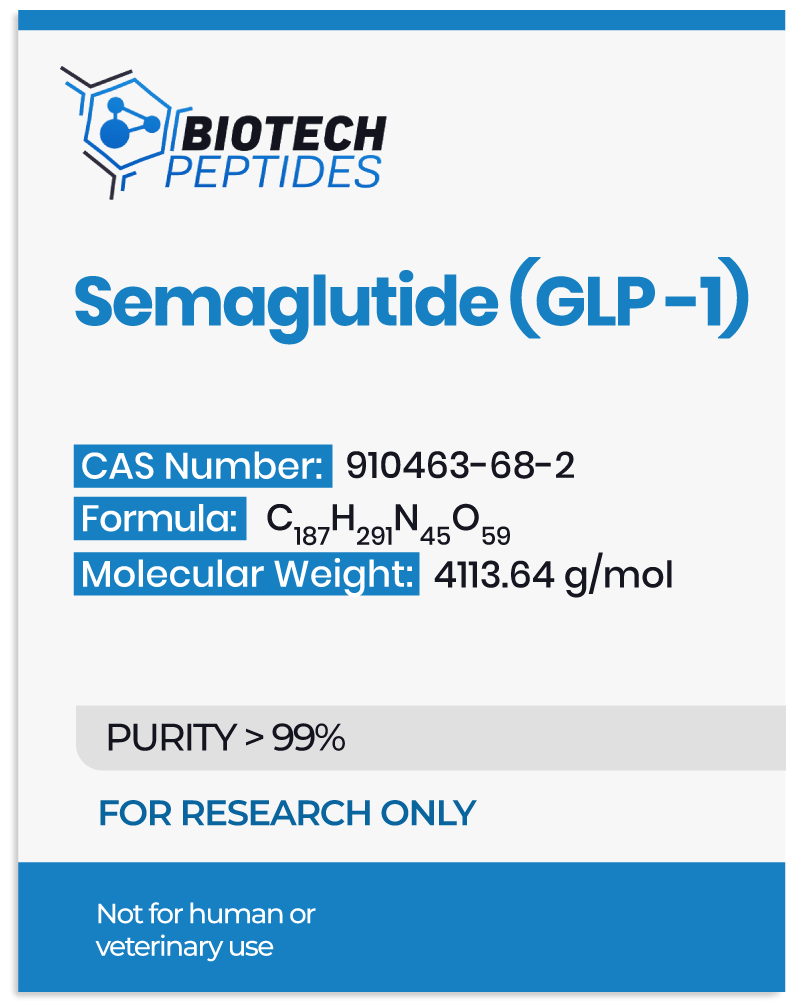Semaglutide peptide is a long-acting GLP-1 receptor agonist that shares a structural similarity with native GLP-1. Researchers have suggested that the compound exhibits an improved resistance to degradation by dipeptidyl peptidase-4 (DPP-4). This modification is assumed to prolong its half-life.[2] Semaglutide is presumed to activate the GLP-1 receptor on pancreatic beta cells by binding itself to it. This may prompt the insulin secretion in a glucose-dependent manner. Simultaneously, it appears to suppress glucagon secretion. Research suggests that this slows down gastric emptying, modulates appetite regulation centers, and contributes to glycemic control, potentially helping weight management.
Contents:
Development of Semaglutide Peptide
The Semaglutide peptide precursor appears to play a vital role in the biosynthesis and maturation of the active peptide. The precursor is a pro-peptide derived from the glucagon-like peptide-1 (GLP-1) analog. It appears to undergo intricate processing within pancreatic cells, influencing the production and secretion of the bioactive Semaglutide molecule. The precursor peptide of Semaglutide is initially translated from the corresponding gene transcript. The post-translational modifications, including cleavage by prohormone convertases such as PC1/3, occur within pancreatic alpha cells. They are considered to facilitate the generation of the mature peptide.[5] This multi-step process involves the removal of signal peptides and the formation of disulfide bonds critical for structural stability.
The mature Semaglutide and its precursor undergo intricate intracellular trafficking mechanisms, after processing. They traverse the secretory pathway, involving the endoplasmic reticulum and Golgi apparatus. There, the proper folding, post-translational modifications, and packaging into secretory vesicles occur. The regulated secretion of the mature peptide involves complex cellular machinery to ensure appropriate release upon physiological stimuli. The Semaglutide precursor appears to serve as a template for the active peptide’s formation and may exert regulatory and modulatory influences within the secretory pathway. It may also participate in the quality control mechanisms. Therefore, researchers suggest, it may act to ensure correct folding and prevent premature degradation. Recent studies also suggest potential intracellular signaling roles of pro-peptides, influencing cellular processes beyond peptide maturation.[6]
The desire to harness the potential of glucagon-like peptide-1 (GLP-1) within the context of type 2 diabetes mellitus (T2DM) and obesity marks the beginning of Semaglutide research. The evolutionary journey of this peptide involves iterative modifications, all aimed at identifying and honing its physiological activity. The quest for GLP-1 analogs started with the recognition of native GLP-1’s potential impact on glucose regulation. However, the peptide’s reputed short half-life due to rapid degradation by dipeptidyl peptidase-4 (DPP-4) called for structural alterations to enhance stability while retaining its purported pharmacological activity. Semaglutide’s development involved meticulous structural modifications. These were mainly focused on alterations in amino acid sequence and attachment of fatty acid side chains. These adaptations aimed to ensure resistance to enzymatic degradation and extend its duration of action.[8]
Preclinical investigations involving cell culture models, animal studies, and pharmacokinetic assessments played a central role in refining Semaglutide’s properties. The findings of these studies first suggested the peptide’s action in improving glycemic control and inducing weight loss.
Research and Scientific Studies
Semaglutide Peptide and Diabetes
Numerous clinical trials have examined Semaglutide’s potential within type-2 diabetes mellitus research.[3] The study findings imply that Semaglutide peptide exhibits superior reductions in HbA1c levels compared to placebo and other antidiabetic agents. Moreover, its effectiveness may extend to obesity research, potentially leading to substantial weight loss in research models with and without diabetes.
The continued research of Semaglutide peptide centers on expanding the understanding of its mechanisms and exploring the potential research applications beyond type-2 diabetes mellitus and obesity. Additionally, researchers also focus on refining Semaglutide’s formulation for improved adherence and outcomes.
Semaglutide and Glycemic Control
Semaglutide peptide has primarily been researched for its potential to enhance glycemic control through glucose-dependent insulin secretion and suppression of glucagon release. Additionally, researchers have suggested its potential in improving insulin sensitivity in peripheral tissues, possibly contributing to better glucose utilization and mitigating insulin resistance.[15]
Semaglutide peptide and Weight, Satiety Control
Semaglutide peptide has been suggested to induce substantial weight loss in research models of type-2 diabetes mellitus, as well as models of obesity. It appears to delay gastric emptying, which may lead to prolonged satiety, and the modulation of appetite-regulating centers in the brain, which seem to collectively contribute to sustained weight reduction.
A study published in October 2022, examining the potential impact of Semaglutide peptide, included obese and overweight research models, with or without type-2 diabetes mellitus.[9] They were divided into two groups. One group received Semaglutide peptide once a week, while the other group received a placebo. The results of the study reported that 69% to 79% of non-diabetic research models in the Semaglutide group recorded an average weight loss of ≥10% by week 68, while 51% to 65% achieved a weight loss of ≥15%, compared to ≥5% – 13% in the placebo group. By week 104, the weight loss was 15.2% in the Semaglutide peptide group versus 2.6% in the placebo group. Obese and overweight models with type-2 diabetes mellitus recorded an average weight loss of 9.6% by week 68, versus 3.4% in the placebo group.
A double-blind, parallel-group study in 2021, suggested that Semaglutide peptide may have led to reduced hunger and prospective food consumption, while potentially also increasing fullness and satiety when compared with placebo.[14] A better control of eating and fewer food cravings were indicated with Semaglutide versus placebo. Body weight was reduced by 9.9% with Semaglutide and 0.4% with placebo.
Semaglutide peptide and Cardiovascular, Renal Function
Emerging research data suggests a potential for Semaglutide peptide to confer cardiovascular action. This may include reductions in cardiovascular events in high-risk cases. Moreover, ongoing research explores its potential influence on renal function. Some findings indicate potential renoprotective characteristics beyond the possible glycemic control.
A study from 2022 examining Semaglutide peptide on cardiometabolic risk factors in research models of obesity states that: “Semaglutide may improve cardiometabolic risk factors and reduce antihypertensive/lipid‐lowering [compounds] use versus placebo in [research subjects] with overweight/obesity without diabetes. These potential benefits were not maintained after … discontinuation”.[10]
Another study published in 2023 suggests that Semaglutide peptide may have improved urine albumin-to-creatinine ratio (UACR) in research models of obesity and type 2 diabetes, respectively.[11] At the same time, in control models, Semaglutide did not appear to affect eGFR decline.
Semaglutide Peptide and Neurology
Beyond its purported metabolic actions, Semaglutide peptide may exert some degree of neuroprotective potential. Researchers hint at its ability to traverse the blood-brain barrier, exerting neurotropic potential and displaying neuroprotective characteristics in models of neurodegenerative diseases.
A 2018 murine model suggests that Semaglutide peptide may potentially have an impact in Parkinson’s disease.[12] Both GLP-1 analogs, Semaglutide and Liraglutide, appeared to have improved 1-methyl-4-phenyl-1, 2, 3, 6-tetrahydropyridine (MPTP)-induced motor impairments in mice. In addition, both rescued the decrease of tyrosine hydroxylase (TH) levels, alleviated the inflammation response, reduced lipid peroxidation, inhibited the apoptosis pathway, and also increased autophagy-related protein expression, to protect dopaminergic neurons in the substantia nigra and striatum, as reported by the researchers.
Semaglutide and Inflammation, Metabolic Modulation
Semaglutide’s potential may extend to modulating inflammatory pathways, potentially exerting anti-inflammatory impact. It also appears to influence various metabolic pathways, impacting lipid metabolism, adipose tissue function, and hepatic steatosis. A 2022 study on mice suggests that the body weight, liver weight, blood glucose, TG, TCHO, LDL, and pro-inflammatory factors of animal subjects were significantly reduced after Semaglutide peptide exposure.[13] At the same time, Semaglutide appeared to have increased the SOD level. The exposure may have also significantly improved the pathological changes such as hepatocyte steatosis, balloon degeneration, and lymphoid foci by HE.
So far, the research results suggest that Semaglutide, a prominent GLP-1 receptor agonist, maybe a significant research innovation in the sphere of metabolic function studies. Its potentially robust activity in glycemic control, combined with possibly substantial weight reduction, may be a paradigm shift in type 2 diabetes mellitus and obesity research.
Disclaimer: The products mentioned are not intended for human or animal consumption. Research chemicals are intended solely for laboratory experimentation and/or in-vitro testing. Bodily introduction of any sort is strictly prohibited by law. All purchases are limited to licensed researchers and/or qualified professionals. All information shared in this article is for educational purposes only.
References:
- Andersen A, Knop FK, Vilsbøll T. A Pharmacological and Clinical Overview of Oral Semaglutide for the Treatment of Type 2 Diabetes. Drugs. 2021;81(9):1003-1030. doi: 10.1007/s40265-021-01499-w
- Mahapatra MK, Karuppasamy M, Sahoo BM. Semaglutide is a glucagon-like peptide-1 receptor agonist with cardiovascular benefits for the management of type 2 diabetes. Rev Endocr Metab Disord. 2022 Jun;23(3):521-539. doi: 10.1007/s11154-021-09699-1. Epub 2022 Jan 7. PMID: 34993760; PMCID: PMC8736331.
- Goldenberg RM, Steen O. Semaglutide: Review and Place in Therapy for Adults With Type 2 Diabetes. Can J Diabetes. 2019;43(2):136-145. doi: 10.1016/j.jcjd.2018.05.008
- Garvey WT, Batterham RL, Bhatta M, et al. Two-year effects of semaglutide in adults with overweight or obesity: the STEP 5 trial. Nat Med. 2022;28(10):2083-2091. doi: 10.1038/s41591-022-02026-4
- Lafferty RA, O’Harte FPM, Irwin N, Gault VA, Flatt PR. Proglucagon-Derived Peptides as Therapeutics. Front Endocrinol (Lausanne). 2021 May 18;12:689678. doi: 10.3389/fendo.2021.689678. PMID: 34093449; PMCID: PMC8171296.
- Cunha FM, Berti DA, Ferreira ZS, Klitzke CF, Markus RP, Ferro ES. Intracellular peptides as natural regulators of cell signaling. J Biol Chem. 2008 Sep 5;283(36):24448-59. doi: 10.1074/jbc.M801252200. Epub 2008 Jul 10. PMID: 18617518; PMCID: PMC3259820.
- Zhao X, Wang M, Wen Z, Lu Z, Cui L, Fu C, Xue H, Liu Y, Zhang Y. GLP-1 Receptor Agonists: Beyond Their Pancreatic Effects. Front Endocrinol (Lausanne). 2021 Aug 23;12:721135. doi: 10.3389/fendo.2021.721135. PMID: 34497589; PMCID: PMC8419463.
- Battle of GLP-1 delivery technologies – Scientific Figure on ResearchGate. Available from: https://www.researchgate.net/figure/A-Half-life-extension-mechanisms-of-acylated-GLP-1-analogs-B-Mean-concentration-time_fig2_326447155 [accessed 6 Dec 2023]
- Bergmann NC, Davies MJ, Lingvay I, Knop FK. Semaglutide for the treatment of overweight and obesity: A review. Diabetes Obes Metab. 2023;25(1):18-35. doi: 10.1111/dom.14863
- Kosiborod MN, Bhatta M, Davies M, Deanfield JE, Garvey WT, Khalid U, Kushner R, Rubino DM, Zeuthen N, Verma S. Semaglutide improves cardiometabolic risk factors in adults with overweight or obesity: STEP 1 and 4 exploratory analyses. Diabetes Obes Metab. 2023 Feb;25(2):468-478. doi: 10.1111/dom.14890. Epub 2022 Oct 28. PMID: 36200477; PMCID: PMC10092593.
- Heerspink HJL, Apperloo E, Davies M, Dicker D, Kandler K, Rosenstock J, Sørrig R, Lawson J, Zeuthen N, Cherney D. Effects of Semaglutide on Albuminuria and Kidney Function in People With Overweight or Obesity With or Without Type 2 Diabetes: Exploratory Analysis From the STEP 1, 2, and 3 Trials. Diabetes Care. 2023 Apr 1;46(4):801-810. doi: 10.2337/dc22-1889. PMID: 36801984; PMCID: PMC10090901.
- Zhang L, Zhang L, Li L, Hölscher C. Neuroprotective effects of the novel GLP-1 long-acting analog semaglutide in the MPTP Parkinson’s disease mouse model. Neuropeptides. 2018;71:70-80. doi: 10.1016/j.npep.2018.07.003
- Niu S, Chen S, Chen X, Ren Q, Yue L, Pan X, Zhao H, Li Z, Chen X. Semaglutide ameliorates metabolism and hepatic outcomes in an NAFLD mouse model. Front Endocrinol (Lausanne). 2022 Dec 9;13:1046130. doi: 10.3389/fendo.2022.1046130. PMID: 36568109; PMCID: PMC9780435.
- Friedrichsen M, Breitschaft A, Tadayon S, Wizert A, Skovgaard D. The effect of semaglutide 2.4 mg once weekly on energy intake, appetite, control of eating, and gastric emptying in adults with obesity. Diabetes Obes Metab. 2021;23(3):754-762. doi: 10.1111/dom.14280
- Andreadis P, Karagiannis T, Malandris K, et al. Semaglutide for type 2 diabetes mellitus: A systematic review and meta-analysis. Diabetes Obes Metab. 2018;20(9):2255-2263. doi: 10.1111/dom.13361







